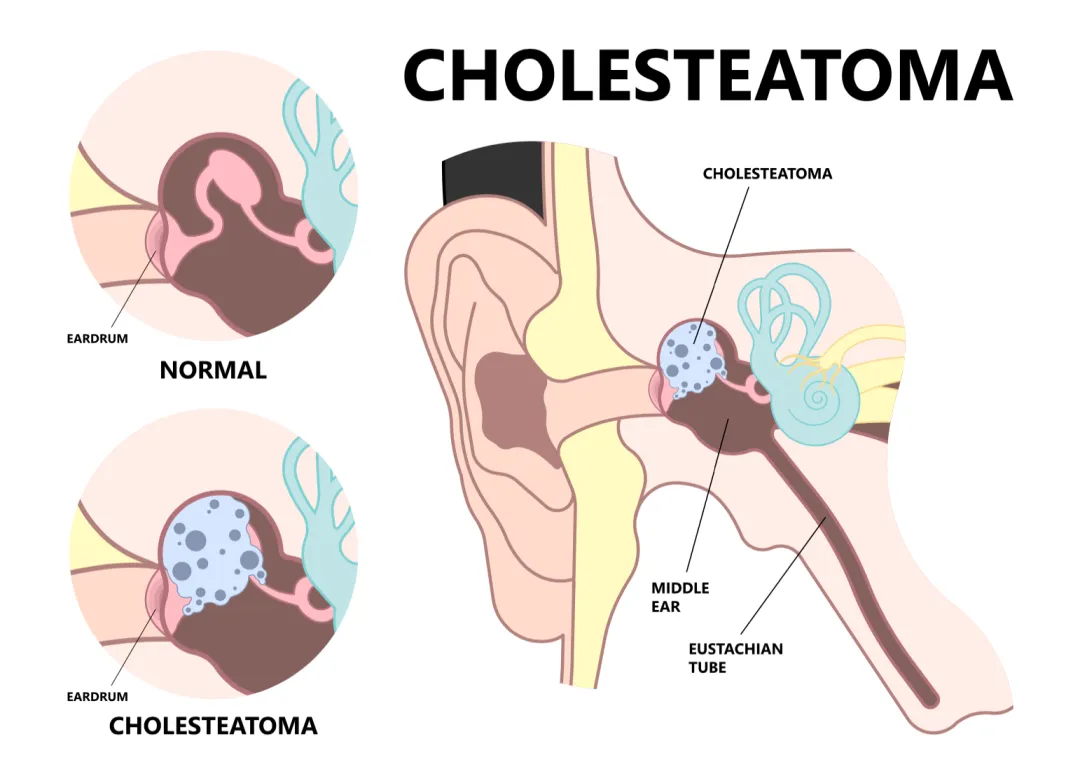It doesn't cause severe pain, yet it continuously expands its territory.
It isn't visible externally, yet it deeply erodes bone, approaching the brain.
It doesn't rupture violently, yet it stealthily steals hearing, even threatening life.
— This is a cholesteatoma,
a "ticking time bomb" buried deep within the middle ear cavity.
Precisely because it feels "unremarkable" and "not serious" in its early stages,
it causes countless people to miss the optimal window for treatment.
Defusing the "Bomb":
What Exactly is a Cholesteatoma?
01
Don't be frightened by the word "tumor," nor misled by "chole-" (fat).
A cholesteatoma is not a neoplasm (cancerous tumor) nor is it related to fat. It is a cystic lesion that occurs in the middle ear and mastoid. The sac contains an accumulation of shed epithelial cells and keratinous debris.
Seemingly "harmless," it can grow larger like a snowball, gradually eroding and consuming the surrounding bone.
The first structures in the ear to "fall victim" are often the ossicles, which are responsible for transmitting sound. Thus, persistent hearing loss becomes one of its most typical early symptoms.
Persistent Hearing Loss: Many people describe a feeling of "the ear being blocked," with sounds becoming muffled.
Recurrent Ear Discharge (Otorrhea): Sometimes the pus may have an odor or contain traces of blood.
Tinnitus and a Feeling of Fullness/Pressure in the Ear: Some patients experience persistent tinnitus or a sensation of "stuffiness" in the ear.
As the condition worsens, more severe manifestations may appear, such as vertigo, headache, facial numbness, or facial paralysis.
Important Reminder: Many people mistake these symptoms for "otitis media" (middle ear infection) and self-medicate with ear drops or clean the ear canal. This not only proves ineffective but also gives the cholesteatoma an opportunity to expand.
The Countdown Has Begun:
Why Does a Cholesteatoma Require Immediate Treatment?
02
The most critical characteristic of this "bomb" is: it does not disappear on its own, and there is no medication to cure it. No drugs can penetrate and clear away that hardened accumulation of keratin.
If left untreated, it will continuously attack the surrounding bone, causing irreversible damage.
Permanent Hearing Damage: Once the cholesteatoma erodes the ossicles, even if surgical reconstruction is performed later, it is difficult to fully restore the original hearing.
Facial Paralysis: The cholesteatoma may invade the facial nerve, leading to stiffness on one side of the face, deviation of the mouth corner, and even impaired control of facial expressions.
Intracranial Infection: If the lesion further erodes the skull base, it can trigger serious complications like meningitis or brain abscess. This not only endangers hearing but can even be life-threatening.
Even without reaching the worst-case scenario, the long-term distress caused by recurrent infections—such as persistent ear discharge and odor—can severely impact a patient's social confidence and quality of life.
A cholesteatoma is silent but carries serious consequences. Therefore, we strongly recommend seeking medical consultation as soon as possible if related symptoms appear!
The Defusing Plan:
Surgery is Currently the Only Curative Method
 03
03
Unlike many diseases, there is no medication that can cure a cholesteatoma. Surgery is currently the only treatment method capable of completely removing the cholesteatoma.
The accumulation of keratin and epithelial tissue is like a "hard shell" hidden within the bone; medications cannot penetrate and clear it. The lesion will only continue to enlarge, destroy more bone, and increase the risk of complications.
Only through surgery can the lesion be thoroughly and completely removed.
For the very few patients who truly cannot tolerate surgery due to severe underlying medical conditions (e.g., uncontrolled hypertension, taking anticoagulants after a cerebral thrombosis, etc.), the only option is regular cleaning at the hospital. However, this is a palliative measure. It comes with issues such as pain during the cleaning procedure, easily induced dizziness, facial numbness, and the possibility of continued discharge after cleaning. It is very distressing for the patient and does not offer a cure.
Dispelling Fears:
Surgery Has Changed Dramatically
04
"Is the surgery risky? Will my hearing recover after surgery? Will there be a large scar behind the ear?"
— These are the genuine concerns in every patient's mind.
In the past, cholesteatoma surgery did indeed cause significant trauma and discomfort for patients, such as requiring shaving of some hair, leaving a long incision behind the ear, and long-term numbness in the post-auricular area. Consequently, many people refused surgery due to fear of pain, scarring, or a long recovery period.
But rest assured, otological technology has changed dramatically. The maturation of endoscopic minimally invasive ear surgery has completely transformed the landscape.
Regarding Risk: All surgeries carry risks, but microscopic ear surgery techniques are now very mature. Main risks include suboptimal hearing improvement, tinnitus, vertigo (usually temporary), taste changes (due to chorda tympani nerve involvement), and a very low probability of facial nerve injury.
Regarding Hearing: The primary goal of surgery is clearance of the disease; hearing reconstruction is secondary. If the ossicles have been destroyed, the surgeon will attempt to implant prosthetic ossicles, either during the same operation or in a second-stage procedure, to improve hearing.
Regarding Scarring: In endoscopic minimally invasive ear surgery, instruments enter directly through the ear canal. There is no need to shave hair, and there is no external skin incision. Even if a small auxiliary incision is needed, it is placed in a concealed location behind the ear, where the healed scar is hidden within the hairline and is very inconspicuous. Furthermore, postoperative pain is minimal, and most patients hardly require any pain medication.
More importantly, the endoscope provides a close-up, magnified, and clear view, allowing the surgeon to operate with a "high-definition map." This enables more thorough cleaning and significantly reduces the likelihood of residual disease.
Please remember one core principle: Early detection and early surgery. The smaller the lesion, the easier the surgery, the lower the risk, and the faster the recovery."
